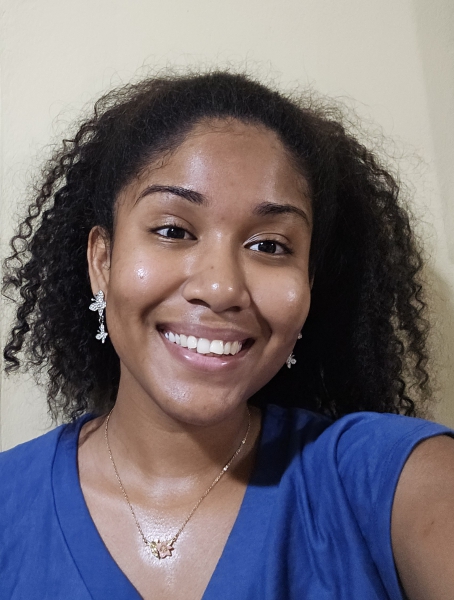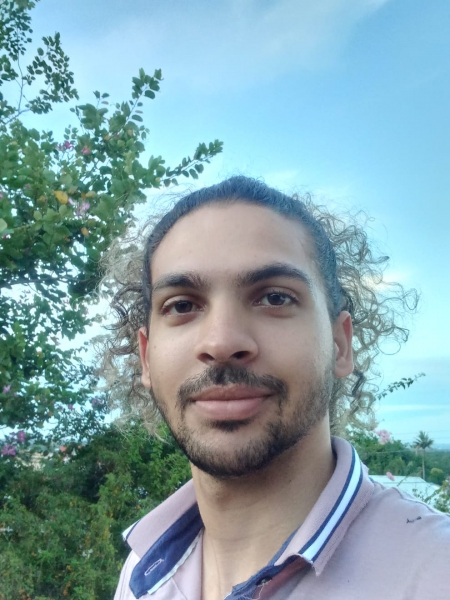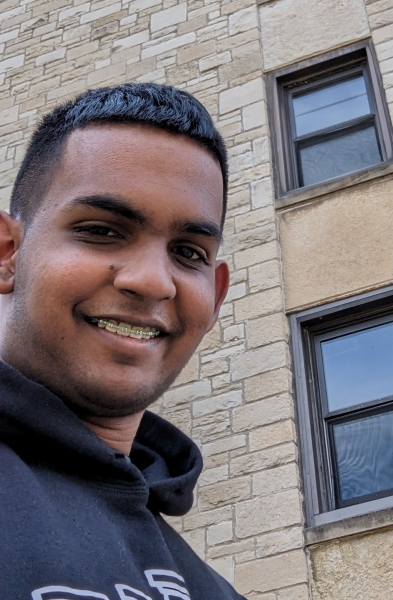Radial 2023 Internship
RADIAL Summer Internship 2023.
Brianna Sampson

RADIAL Experience
Being accepted for this internship was the confirmation I needed that switching to a Physics Degree was one of my greatest decisions. I studied Electrical Engineering for a year before deciding that I did not want to pursue it anymore. One of my passions is astrophysics but the University of the West Indies does not offer an astrophysics degree. Instead, I chose a Physics major degree and did the course ‘Introduction to Astronomy’ as an elective in the first semester of my first year. That class was always the highlight of my week and the lecturer, Professor Shirin Haque was my favourite professor. In the second semester of first year, Professor Haque presented the internship to the group of students who attended her telescope workshop. She urged me to apply and even wrote one of my recommendation letters. This internship was a part of the Radio Astronomy Data Imaging and Analysis Lab (RADIAL) program from the National Radio Astronomy Observatory (NRAO) which was hosted at the University of Wisconsin for 10 weeks. This was the first time that I travelled out of my country as well as the first time I travelled alone. Even though I missed my second flight and had to rebook them, I landed in Madison, Wisconsin. This was also my first time living in a dorm with the other interns from my Astrophysics Research Experience for Undergraduates (REU) as well as other REUs. Those 10 weeks were filled with coding workshops, professional development workshops, meetings with advisors, learning how to code for the research, visual inspection of 1441 images, exploring Madison with friends as well as organized internship trips. These trips included a camping trip to Perrot State Park Trempealeau, Wisconsin and a visit to Fermi Lab in Batavia, Illinois. Through the research, I learned to code, assess data quality, learned how to create and present an effective presentation, how to write a research abstract and how to create a poster presentation.
The following is the abstract for my presentation:
“Giant Radio Galaxies (GRGs) are rare varieties of Active Galactic Nuclei (AGN) with jets spanning more than 0.7 Mpc, and their angular sizes make them difficult to identify in radio images. The Tata Institute for Fundamental Research Giant Metrewave Radio Telescope Sky Survey (TGSS) is a radio survey at 150 MHz and 25 arcsecond resolution. 17,724 double lobed radio sources were found in the TGSS data using the DRAGNhunter algorithm (Gordon et al. 2023). After applying the parameter of a Largest Linear Size (LLS) > 0.7 Mpc to the sources with an identified host galaxy candidate with a redshift measurement, the 17,724 sources were reduced to 1,441 candidates that could be GRGs. Following inspection, of the radio and optical images, 143 sources were found to be spurious. Since the TGSS data has a low resolution, the images were compared to the corresponding images in the Faint Images of the Radio Sky at Twenty centimeters (FIRST) data which is a radio survey at 1.4 GHz. The estimated reliability of the TGSS data from this comparison was 90%. 101 matches within 90 arcsecs were found between the 1290 candidates and the known list of GRGs. Thus, there are potentially 1,197 previously undiscovered GRGs in the TGSS data.”
These are results from a proof-of-concept method. Therefore, I will continue to work with my advisor, Yjan Gordon to get a more conclusive list of the GRGs in the TGSS data. This internship has been a wonderful experience and a great insight into the world of research and has taught me that I would love to do more research in the future. The RADIAL program is both a great experience to visit a university town and to experience what research entails.
Che Pohlmann

Title: Radio AGN and galaxy clusters: Insights into IGM measurement and gravitational lensing.
Double Radio sources associated with Active Galactic Nuclei (DRAGNs) are double radio jets produced by supermassive black holes typically found at galactic centers. This research looks at two objectives, firstly the detection of AGN whose jets were bent due to ram pressure and secondly, to identify potential gravitationally lensed radio sources. The first goal of this study is to increase the sample size of known bent jets within galaxy clusters to calibrate a method of estimating the density of the intergalactic medium (IGM) in sparser environments by measuring the radio jets’ bending. Furthermore, we can investigate the viability of searching for gravitationally lensed DRAGNs existing in radio sky surveys as it is most probable to find gravitationally lensed DRAGNs along a line of sight that passes close to a galaxy cluster. Catalogues from the Very Large Array Sky Survey (VLASS), FIRST (Faint Images of the Radio Sky at Twenty cm), TGSS (The TIFR Giant Meterwave Radio Telescope Sky Survey) and ACCEPT (Archive of Chandra Cluster Entropy Profile Tables) were used in this work. DRAGNs from the TGSS and FIRST catalogues were cross matched with the ACCEPT catalogue to determine which DRAGNs lie within 1800 arcseconds from the galaxy cluster center and then compared to their VLASS equivalent. From the FIRST cross match, 94 DRAGNs were found, of which 7 were bent jet AGN. The TGSS cross match produced 99 DRAGNs including 4 bent jet AGN. While none of the DRAGNs found from either could be confirmed to be newly discovered gravitationally lensed radio sources, the bent sources more than double the sample we are using to validate and calibrate an approach to estimate the IGM density in sparser environments like galaxy groups (e.g., Freeland &Wilcots 2011, ApJ, 738, 145). Finding bent doubles in clusters with sufficient quality x-ray data is key, because the x-rays and bending of the radio jets provide independent estimates of the IGM density in the clusters. The insights gained from this comparison will inform the interpretation of density estimates in galaxy groups that have only bent radio jets but are undetected in x-rays.
This work was supported by the National Science Foundation's REU program in Astrophysics through NSF award AST-2150222. Additional support was provided by the Radio Astronomy Data Imaging and Analysis Lab (RADIAL) Research & Training Experience program through the National Radio Astronomy Observatory; and by the Alfred P. Sloan Foundation's Creating Equitable Pathways to STEM Graduate Education Program.
Soren Ramdhanie

It is easy to underestimate the work that goes into being a scientist. This summer (2023) I had an incredible opportunity to conduct meaningful astronomical research with a renown scientist at the University of Wisconsin-Madison. I was afforded the opportunity to live on-campus and work face-to-face with my mentor, Dr. Yjan Gordon, on his investigation into giant radio galaxies (GRGs). Specifically, my task was to search for previously undetected GRGs from the FIRST (Faint Images of the Radio Sky at Twenty centimeters) sky survey. After weeks of filtering, calculating, searching and analyzing, I found around 90 possible GRGs. After some additional cross-checking with other scientists, my mentor was able to reduce the list down to 63 confirmed new discoveries. This work is to be published in the RNAAS. Outside of work, I had opportunities to make friends with fellow research interns and astronomy-enthusiasts from all over the USA. My main advice to anyone in a similar situation: go out and have fun! Together, my friends and I explored practically the entire city of Madison, Wisconsin and did as much as we humanly could in the short 10 weeks we had. We went shopping, clubbing, camping, hiking, and touring. We even got to visit Fermilab in Illinois, and by the end, we met over a dozen scientists performing groundbreaking research in many subjects linked to astronomy such as particle physics and the engineering of scientific equipment.
The city of Madison itself is almost entirely bikeable or walkable. It also has a comprehensive public bus system. It’s clean, safe, and hosts tons of events during the summer including farmer’s markets, night markets, art shows and open-air concerts. The university has an astronomy interest-gathering group that does lectures and star-gazing sessions in the various parks around the city. There is a very large variety of restaurants and stores all within walking distance from our dormitories. Generally, the people are quite progressive and accepting. At no point did I feel completely out-of-place as an outsider. Overall, this summer has been the best summer of my life so far. The research experience taught me a lot about how real science works. It’s a huge community of people who want to learn, discuss what they’ve learned, and help you to learn more. It was a genuinely life-changing experience. I have never been so sure about the direction I want my life to go. My eyes have been opened to the endless possibilities out there in the world. I no longer feel confined to Trinidad. I am confident now in the fact that if you put your mind to something, life will find a way to give it to you.






